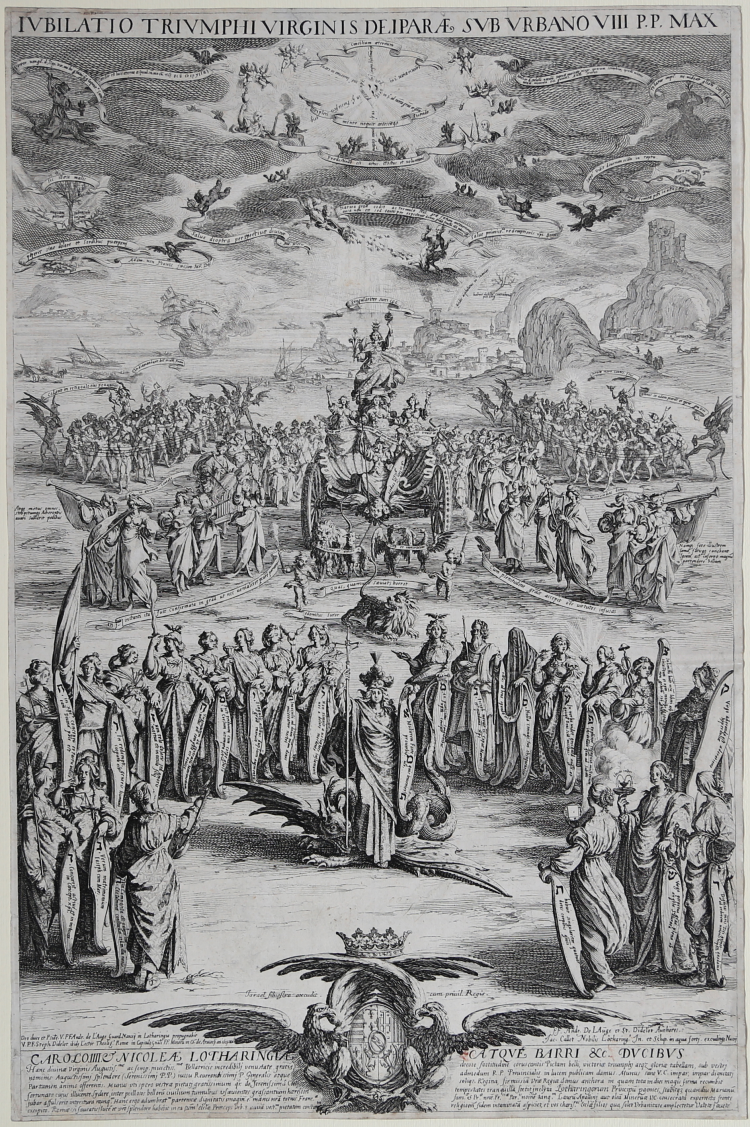



| Reference: | S30087 |
| Author | Jacques CALLOT |
| Year: | 1625 |
| Measures: | 368 x 563 mm |


| Reference: | S30087 |
| Author | Jacques CALLOT |
| Year: | 1625 |
| Measures: | 368 x 563 mm |
Thesis: the triumph of the Virgin; allegorical figures holding inscribed shields in the lesser part, surrounding an armed woman trampling a dragon; in the centre, the Virgin on a carriage, wearing a triple crown, holding a lily and a sphere, surrounded by figures playing music, with groups of the damned on each side; fortified cities and ships in the background; cherubs, allegorical figures, inscribed banderoles and shining heart in the sky; coat of arms at the bottom.
Etching, 1625, lettered with inscriptions, dedication to Charles IV and Nicole of Lorraine, production and publication detail: 'Iac. Callot Nobilis Lotharing In. et Sclup. in aqua fortj. excuditq Naceij'.
Example of the rhird state, with Silvestre imprint.
A fine impression, printed with tone on contemporary laid papere, trimmed to the platemark, very good condition.
The work was commissioned to Callot for a theological thesis supported in 1625 in Rome by the friar Etienne Didelot. Dedicated to Charles IV and the Duchess Nicole, the work is described in the plate as the image of war, of victory, of triumph and of the glory of the Virgin.
The great composition can be divided into many small scenes, all explained by Latin inscriptions, having only one common denominator: Marian devotion. The work conveys the figure of a strong, dominant woman, sometimes depicted with the allegory of Rome Triumphant, still associated with the iconography of the Immaculate Conception. According to some scholars, the work represents the highest testimony of the Marian cult in the Confraternity of the Franciscans, which was expressed at most during the holy years.
Numerous preparatory drawings for the work are preserved at the Nancy museum.
Bibliografia
Meaume 1860 100.II; Lieure 1927 562.III; Mostra di Nancy, 694.
Jacques CALLOT (Nancy 1592 - 1635)
|
He was a baroque graphics artist, draftsman and printmaker from the Duchy of Lorraine (an independant state on the North-Eastern border with France). He made etchings that chronicled the people and the life of his period (soldiers, clowns, drunkards, wanderers, beggars, and various outcasts). These images of people are often contrasted by spectacular landscapes (see, for instance, "The Temptation of St. Anthony"). His skill in shading and his use of different tones were remarkable for the period and he is often compared to Albrecht Dürer.
|
Jacques CALLOT (Nancy 1592 - 1635)
|
He was a baroque graphics artist, draftsman and printmaker from the Duchy of Lorraine (an independant state on the North-Eastern border with France). He made etchings that chronicled the people and the life of his period (soldiers, clowns, drunkards, wanderers, beggars, and various outcasts). These images of people are often contrasted by spectacular landscapes (see, for instance, "The Temptation of St. Anthony"). His skill in shading and his use of different tones were remarkable for the period and he is often compared to Albrecht Dürer.
|